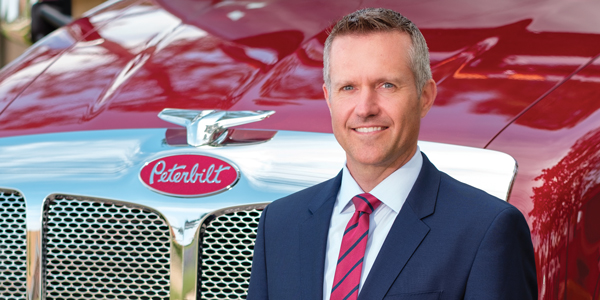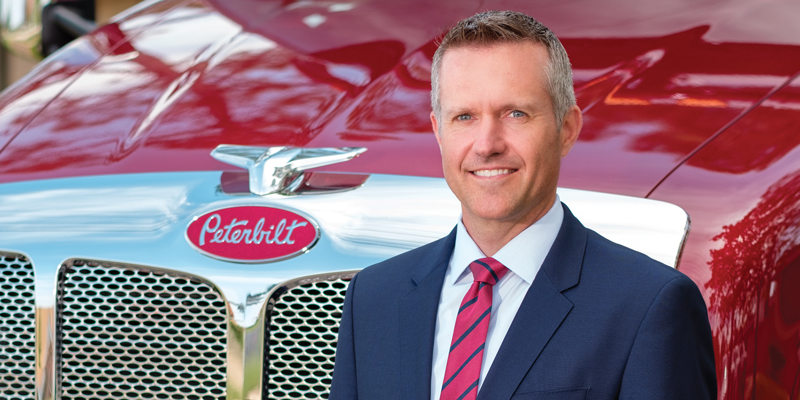
Jason Skoog is connected. Tech companies. Customers. Suppliers. Global PACCAR collaborators. He’s one of the freshest faces on the truck OEM leadership stage, but he displays a depth of market knowledge and robust industry network thanks to more than 25 years of trucking experience within PACCAR. Those are the right tools for his position as Peterbilt general manager and PACCAR vice president to help ensure that Peterbilt delivers on equipment expectations set by its large orderboard, continues the development of electric trucks and automated driver assistance systems, and wins the battle to better dealer service operations (because fast is never fast enough).
“It’s such a dynamic business, and what excites me is that at the end of the day, it’s still a people business. Relationships still matter,” he says. He’s sitting in his office at Peterbilt’s Denton, Texas, HQ, his home base when work isn’t taking him out to the PACCAR Innovation Center in Silicon Valley, meetings at PACCAR’s headquarters in Bellevue, Wash., or across the country meeting with customers.
“I enjoy the relationships within the building, talking with our people here and getting the most out of working together,” he continues. “I enjoy being out and talking to customers and dealers about how their businesses can be better and how Peterbilt can better serve them.”
“I feel like I grew up in the truck business, and I really love that personal aspect of this business.”
Those business relationships are constructed on a foundation of trust: Being there when you say you’re going to be there; being honest about expectations and delivering what you promise. As today’s truck equipment environment spins with headlines making big promises and bold claims when it comes to new developments, Jason takes a pragmatic approach.
“If a customer buys a Peterbilt, whether it’s a diesel powertrain, or in the future, an electric truck, it’s got to perform like a Peterbilt,” he says firmly. Peterbilt takes its heritage seriously in both brand and equipment performance, and Jason doubles down on that as he hammers on the high expectations that Peterbilt electric trucks will have to meet.
“I believe electric trucks will be a business reality, the question is: When?” Jason confidently notes that Peterbilt will have 36 electric trucks spread across the classes as the medium-duty Peterbilt Model 220EV cab-forward recently joined the heavier Model 520EV and the heavy-duty Class 8 Model 579EV. All of those trucks will be in real-world service by the end of the year.
“That’s a strong number if you look at other announcements from some other OEMs,” Jason says. “Thirty-six, across three platforms, from what I’ve seen, we are leading the industry in electrification .”
Peterbilt is also testing one of the widest arrays of electric truck powertrain solutions—from the mid-ship motor and adapted transmission as seen in the Peterbilt Model 579 to the Meritor Blue Horizon two speed drive eAxle propelling the Model 220EV into unannounced applications later this summer. What Peterbilt learns from its electric truck trials, Jason will share with his customers whose needs are never far from his thoughts.
“The plan is to accumulate as many miles as we can to learn, and then we’ll share what we found,” He says. “So: A certain configuration works best in a regional haul application. Whereas this other configuration works best in an inner-city delivery application. We always take anything that we know about our product and share that with our customers so that they can spec the best truck for their application. That goes whether it’s an electric truck or a diesel-powered truck. It doesn’t matter. We’re always trying to work with customers to spec the best truck for their application.”
As you know, you can have the best truck in the world, but if it’s not rolling, it’s not working. It’s fun to talk about future equipment, but Jason understands the real fight fleets are facing on today’s roads and quickly steers the conversation back to the needs of today: Driver retention and uptime.
“For 25 years I’ve been in front of customers, and I’ve never not had a conversation about there being a driver shortage,” he says. “There’s always a driver shortage in this industry, and I think that what you’ve seen recently, especially the larger customers, is they have taken the average age of their fleet lower to aid with that driver turnover number and drive the ability to recruit a driver.”
One of Peterbilt’s strongest answers to the question of driver recruitment and retention is the Model 579 UltraLoft.
“It’s a changing landscape for sure. We’ve got the team in Silicon Valley, we’ve got our advanced concepts group here, and they talk regularly with all the players.”
“The spaciousness of its sleeper, the spaciousness of its cab,” Jason says extending his arms, raising his hand to convey the expansive space, “those are the type of things that are motivating customers to continue to want to buy new trucks.”
Available in two configurations, one sporting a spacious single bed configuration, the other offering a roomy double bunk setup, both 80-in. integral sleepers offer massive amounts of headroom, 70 cu. ft. of storage space, with both lower bunks measure in at 85 in. long and 42 in. wide; the double bunk configuration adds an 82 in. long, 36 in. wide upper bunk.
“Fleets are constantly trying to win that battle for the driver,” Jason says. “Depending on who you talk with, you’ll hear that the cost to recruit a new driver averages between $5000 and $8000. What fleets have to do is an internal calculation to say, ‘Okay, if I make my fleet newer, do I get the resulting change in turnover that I was expecting?’
“I think the sophisticated ones are making that calculation, and I think a lot of other fleets need to make that calculation, because if they can prove that a younger fleet or a Peterbilt Model 579 UltraLoft can reduce driver turnover, saving $5000 to $8000 per driver, then that overcomes the price of a premium high-roof integral sleeper.”
Since the UltraLoft’s unveiling in March of 2018, Peterbilt has taken more than 10,000 orders for the truck and earned 34 new fleet customers, who have collectively ordered 2,100 of that total. But Jason knows that he can sell all the trucks in the world, but he will quickly lose the customers Peterbilt has gained if the OEM can’t help its customers keep the truck on the road when an unexpected service event happens. And events do happen, no question.
Enter PACCAR Solutions Service Management.
It’s a data-driven service portal that puts all of Peterbilt’s servicing dealers on the same digital footing and provides fleets visibility into the service process and aims to enhance the service process.
“Customers can approve purchase orders online. They can see what the status of their vehicle is in the service shop and then the system can notify the customer when the truck is ready to be completed,” Jason explains. “On our end, dealers select the asset check-in button, the triage completion button, the RO-issued button, the asset ready button, we now have an objective way to measure dwell time at every one of our locations.”
It should come as no surprise that Jason is excited to share that information.
“PACCAR Solutions Service Management will allow a fleet to know the dwell time in individual dealer locations,” Jason says. “Fleets will be able to see and understand that if they go to dealer X, the dwell time is Y. If they go to dealer A, the dwell time is B. We’ll show location: These dealerships are 50 miles apart, and so fleets are able to choose one dealer location over another because they have objective data—not subjective data. They’ll know they’re going to get their truck out faster.
“As we talk to the Peterbilt dealer network about these technologies, they certainly understand that there’s that new level of accountability coming, and they’re ready to take it on.”
“We have our finger on the pulse of what’s going on, and I think you’re going to continue to see some change in the landscape because it’s all emerging technology.”
Currently, more than 90% of the Peterbilt dealer locations are plugged into PACCAR Solutions Service Management portal with 100% coming onboard later this year.
Smart fleets will play an active role in the service relationship, leveraging their own data points to match up with the points provided by Peterbilt to become even more efficient and productive.
“Now that we’ve got electronic logs and driver productivity is at a whole new level, I think that the fleets that are using data wisely are the ones that understand that when a check engine light comes on and their driver has four more hours, then they can look ahead to see where their driver will be in four hours. From there, we’ll tell them this code is not severe via SmartLINQ, our remote diagnostics platform, so that they can tell their driver to keep going until his or her hours of service are up and get them to the nearest dealer within that timeframe.
“And that’s the power of remote diagnostics.”
It’s all connected. The rollout of PACCAR Solutions Service Management, the growing interest in the UltraLoft, the development of electric trucks—each advancement informs a new opportunity to do better and elevates the expectations that Peterbilt sets for its solutions. Just as change is a constant, so too is the importance of forging a relationship by working with people because some things—the really important things, valuable things–never change.
“I haven’t seen a change in this business where a customer wants to only communicate by phone or only wants to communicate by email,” Jason says. “Sitting down and going through the specs still happens. Sitting down and negotiating the transaction still happens. Human interaction and the relationships in this business still matter, and they help us be better and they help our customers be better and they help our dealers be better.”
Check out the rest of the July digital edition of Fleet Equipment here.














